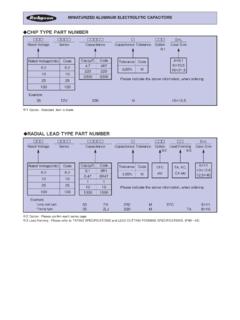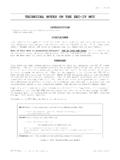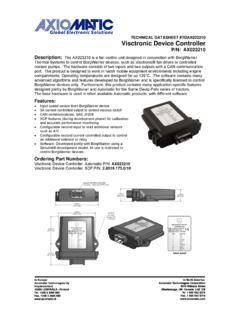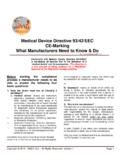Transcription of 3. PERFORMANCE OF ALUMINUM ELECTROLYTIC …
1 RUBYCON CORPORATION 5 technical notes FOR ELECTROLYTIC CAPACITOR 3. PERFORMANCE OF ALUMINUM ELECTROLYTIC CAPACITOR ALUMINUM ELECTROLYTIC capacitor has the features that it is small in size but has high capacitance. General performances of ALUMINUM ELECTROLYTIC capacitor are described hereunder. Capacitance and Energy Storage Capacitance of a capacitor is generally expressed with the following formula: C = X 10-8dSH ------ C: Capacitance (PF) H: Dielectric constant S: Area of facing electrodes (cm2) d: Distance between electrodes (cm) On ALUMINUM ELECTROLYTIC capacitor, S is effective surface area of anode foil enlarged to 60 to 150 times of the projected area through etching process.
2 D corresponds to the thickness of dielectric (13 to 15 angstroms per volt). Dielectric constant H of ALUMINUM oxide film is Electric charges Q (Coulomb) stored in capacitor when the voltage V (volts) is applied between the terminals are expressed as follows: Q =VC ------ The work W (Joule) made by the charge Q is expressed as follows: QVWuu 21 221 VCuu ----- Tangent of Loss Angle (tan G) and ESR When a sinusoidal alternating voltage is applied to an ideal capacitor, the current advances by S/2 in phase.
3 In the case of a practical capacitor, however, advance in phase is (S/2 - G), which is smaller than S/2. G is referred to as Loss Angle. (Refer to Fig. ) One of the reasons why loss angle arises is electric resistance of materials used in ELECTROLYTIC capacitor, including the intrinsic resistance of foil, resistance of electrolyte and resistance of terminals. Another reason is time required for lining up dipoles of dielectric, which is also the time necessary to bring polarization into equilibrium. Equivalent circuit of ALUMINUM ELECTROLYTIC capacitor is schematically shown in Fig.
4 Fig. Fig. C: Ideal capacitance (F) R: Equivalent series resistance (:) L: Equivalent series Inductance (H) fCRXcRSG2tan ------ R in above formula is referred to as Equivalent Series Resistance (ESR). Leakage Current When a DC voltage is applied to a capacitor with the capacitance of C through a series resistance (ESR), current I, passing through the capacitor, changes with time as shown in Fig. , which is expressed by the formula I = Ic + Ia + Il ------ Ic: Charging Current Ia: Absorption Current Il: Leakage Current Fig.
5 Total current passing through capacitor reduces rapidly in the beginning with the change of Charging Current Ic determined by the capacitance C and ESR, the change of current being gradually moderate to converge into Leakage Current Il after the effect of Absorption Current Ia runs out. Leakage current of capacitor is essentially the final current, but practically the current 1 or 5 minutes after applying DC voltage to capacitor is deemed as leakage current , because it takes too much time to measure the true leakage current.
6 RUBYCON CORPORATION 6 technical notes FOR ELECTROLYTIC CAPACITOR It is said that generation of Absorption Current is related to the change in polarization of dielectric with the passage of time and response time of space charge polarization would affect it. It is also said Voltage Recurrence Phenomena, such that voltage arises between terminals of capacitor even after discharge, is related with the delay in response time of above space charge polarization. Impedance Impedance of capacitor is typically expressed with capacitive reactance fCXcS21 , but the impedance of a practical capacitor is different and expressed as shown in the formula , considering the effects of ESR and inductive reactance XL = 2 SfL according to the equivalent circuit shown in Fig.
7 22212fCfLRZSS Fig. is the schematic illustration of Z, where Xc is predominant in low frequency range, ESR around the resonance point, and XL in high frequency range. Fig. Temperature Characteristic Characteristics of ALUMINUM ELECTROLYTIC capacitor are temperature dependant. Due to the property of electrolyte used for ELECTROLYTIC capacitor, capacitance can remarkably reduce and ESR and the tangent of loss angle can increase in low temperature range. The reason is the increase in viscosity and resistance of electrolyte induced from reducing ionic mobility.
8 Capacitance change over operating temperature range is shown in Fig. , the tangent of loss angle (tan G) in Fig. and leakage current in Fig. Fig. Fig. Fig. Frequency Characteristic Characteristics of ALUMINUM ELECTROLYTIC capacitor are also frequency dependant. Capacitance and ESR reduce as measuring frequency increases. The change of impedance is described in However the rate of the change is not constant, the presumed reasons are as follows: 1) Condition of etched surface of ALUMINUM foil 2) Property of ALUMINUM oxide film as dielectric 3) Property of electrolyte 4) Construction of capacitor Frequency-response curves of capacitance and ESR are shown in Figs.
9 And respectively. (50V 10PF, I5x11L) RUBYCON CORPORATION 7 technical notes FOR ELECTROLYTIC CAPACITOR Fig. Fig. Shelf Life When ALUMINUM ELECTROLYTIC capacitor is stored for a long time without electric charge, leakage current and ESR may increase and capacitance may decrease. However such changes are very small after the storage around two years at room temperature for general capacitors or after around 6 months for low leakage products, so that it will not be a practical problem.
10 It is explained that such changes are caused by chemical reaction between electrolyte and ALUMINUM oxide film. One of the reasons why leakage current increases is the penetration of electrolyte into defects in the oxide film in lieu of the diffusion of oxygen protecting the defects into bulk electrolyte. If capacitor is exposed to high temperature atmosphere, sealing material can be degraded to lower sealing power and electrolyte can be lost due to dissipation; both of which may bring change in characteristics. General changes of each characteristic under Shelf Life Test at 85 C are shown in Figs.












![Caviwave Sonic Console TD[2] - mplusmedtech.com](/cache/preview/7/a/c/5/5/2/9/c/thumb-7ac5529cc9ea5df817c40eccb2a6fadf.jpg)
